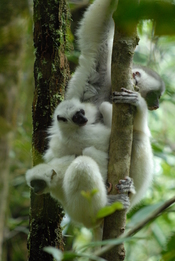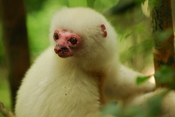Propithecus candidus, Silky sifaka
Javeria Zafar
Biology 3484a
Tutorial Section 005
Jessica Clapp
The Propithecus candidus Grandidier , 1871 also known as a silky sifaka, is a large lemur that belongs to the Indriidae family, in the order Primate, class Mammalia, phylum Chordata and kingdom Animalia (1). P. candidus has distinctive features such as its long white fur, that set it apart from the 3 other subspecies of Propithecus diadema to which it belongs. Found primarily in the northeastern rainforests of Madagascar, P. candidus has a very restricted geographical range (2). Within this range, distribution of the species is patchy and at low densities. The sifaka habitat is characterized by moist, tropical forests located at higher altitude elevations (1)(3). This type of habitat provides ample plant material for the herbivorous mammal. The P. candidus has morphological speciality to consume foliage, which makes up a large part of its diet, especially in the dry season.
It is also known to consume fruits, seeds and flowers (4). The role of the P. candidus on its environment is not fully understood due to the lack of date collected on the subject (3). However it is speculated that because of its consumption of seeds and fruits, the sifaka may play a role in seed dispersal for the plants species it consumes (3) (4). Additionally, P. candidus serves as a food source for both humans and Cryptoprocta ferox or the fossa, a well-known predator of the mammal (1)(4).
The silky sifaka is one of the most threatened lemur species located in Madagascar and as such is listed as critically endangered on the IUCN red list (1). There are two main threats to silky sifaka: anthropogenic influences and habitat disturbances (1). The immediate anthropogenic threat is the hunting of the sifaka by humans. Since...


